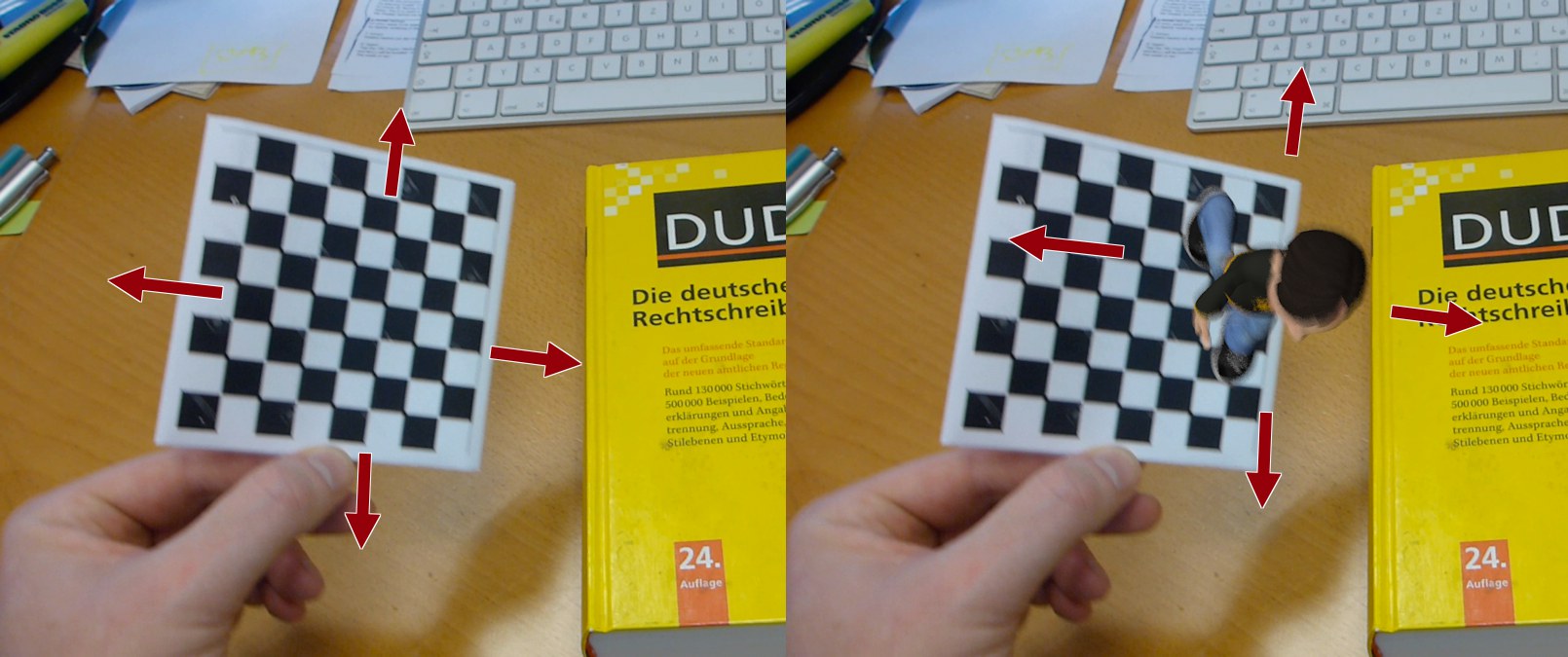Object Tracker
![]()
With the Object Tracker you can follow (track) moving objects within the footage that move independently from the camera. There is a difference between Camera Tracking (reconstruction of the recording camera using the video material) and the Object Tracking described below.
If the checkered pattern below were in motion it can be tracked and a 3D plane can be created, for example, whose motion behaves correctly with regard to perspective.
 The Motion Tracker can be used to calculate moving objects in video footage and precisely assign 3D objects to them.
The Motion Tracker can be used to calculate moving objects in video footage and precisely assign 3D objects to them.
Make sure that the tracked object has numerous, easily recognizable markings (e.g., stuck on "x"s on all tracked objects) that Cinema 4D can use as clearly assigned Tracks.
The Object Tracker only works in conjunction with a Motion Tracker object (which contains Tracks). This link (see also Motion Tracker) is made automatically when a Motion Tracker object exists when an Object Tracker object is created. Otherwise it will be linked with the currently selected Motion Tracker object.
If multiple regions within the video footage have to be tracked, create a separate Object Tracker object for each region (still with a single Motion Tracker object). Tracks can be assigned to different Object Tracker objects (in case you want to experiment with different Geometry Objects).
Use
Proceed as follows to create object tracking:
-
Create a Motion Tracker object
-
Load a video sequence into the Footage tab
-
Create a sufficient number of Tracks for both the camera tracking (if desired) and the tracked object
-
Create an Object Tracker. This will automatically be linked with the Motion Tracker object that was created first
-
Select all Tracks (scroll through the footage to make sure all are selected) on the tracked object and assign them to the Object Tracker (RMB). This makes it possible for the Motion Tracker object to differentiate between the camera tracks for the solved camera and the Tracks on the moving object (both independent of one another)
-
Optionally, the camera can first be solved (Run 3D Solver button in the Motion Tracker Object's Reconstruction tab). This is not necessarily required for object tracking but should be done in most cases for a complete 3D solve (if only to solve the camera's focal length, which would otherwise have to be entered manually). Make sure that the Lock Solved Data option in the same tab is enabled so the solve does not get confused when subsequent changes are made to the Object Tracker’s Tracks.
Then the object tracking can be done. You should differentiate between the following 2 cases:- If you want to run a geometry-supported solve (see Geometry Object for details), drag the respective object into the Geometry Object field in the Object Tracker's Trackers tab. The object must be positioned correctly (with regard to perspective) in front of the object to be tracked. When doing so, the scene has to be viewed through the solved camera (if this does not exist, then through the Viewport camera).
- If a solve without geometry (see Geometry Object for details) is done (for which more Tracks are required), the Geometry Object field must be empty.
- Click on the Run 3D Solver button in the Object Tracker's Reconstruction tab.
If the 3D object solve was successful the Object Tracker will have the position and rotation keyframes needed to track the movements of the object to be tracked. 3D objects can now be inserted and made Child objects of the Object Tracker, which will let them move with it accordingly.
Without geometry-supported solving you will (similar to camera tracking without using a Motion Tracker Tag) have a group of points without any logical scale, position or rotation. It is recommended that the solved points be calibrated using the Motion Tracker Constraint tag (see Geometry Object).
If the 3D solve was unsuccessful it will often be due to poor or too few (minimum: 3 for geometry-supported reconstruction, 7 for a reconstruction without geometry) Tracks. In this case, create additional object Tracks, if possible, or optimize the existing Tracks (see also What are good and bad Tracks?) and will reconstruct them again.